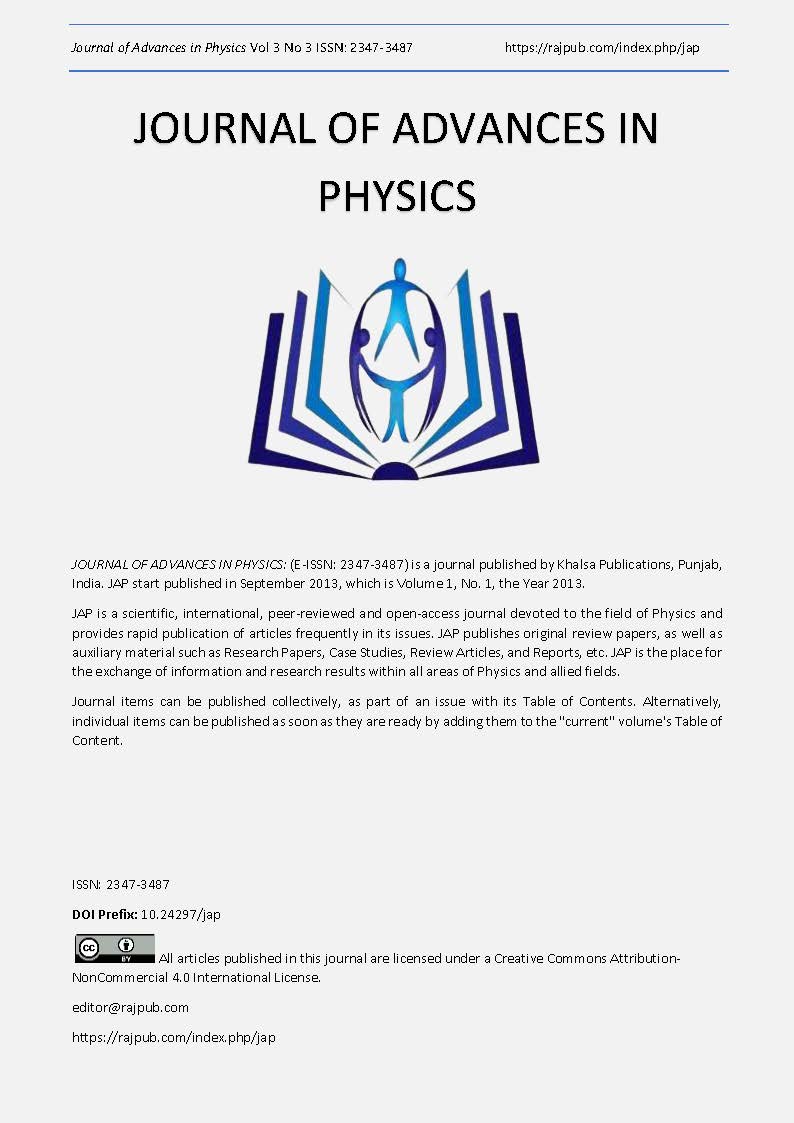The Uncertainty Principle Derived by The Finite Transmission Speed of Light and Information
DOI:
https://doi.org/10.24297/jap.v3i3.2059Keywords:
Quantum to classical transition, quantum decoherence, open quantum systems, quantum measure, quantum hydrodynamic analogy, non-local interaction and finite speed of lightAbstract
This work shows that in the frame of the stochastic generalization of the quantum hydrodynamic analogy (QHA) the uncertainty principle is fully compatible with the postulate of finite transmission speed of light and information. The theory shows that the measurement process performed in the large scale classical limit in presence of background noise, cannot have a duration smaller than the time need to the light to travel the distance up to which the quantum non-local interaction extend itself. The product of the minimum measuring time multiplied by the variance of energy fluctuation due to presence of stochastic noise shows to lead to the minimum uncertainty principle. The paper also shows that the uncertainty relations can be also derived if applied to the indetermination of position and momentum of a particle of mass m in a quantum fluctuating environment.
Downloads
References
M., Schlosshauer, Decoherence and the Quantum-to-Classical Transition (1st ed.). Berlin/Heidelberg: Springer (2007).
Heisenberg, Physics and Philosophy: The Revolution in Modern Science (New York: Harper and Row, 1958). Lectures delivered at University of St. Andrews, Scotland, Winter 1955-56.
D. Bousquet, K. H. Hughes, D. A. Micha, and I. Burghardt, Extended hydrodynamic approach to quantum-classical nonequilibrium evolution I. Theory. J. Chem. Phys. 2001; 134.
J., P., Paz, W., H., Zurek, Fundamentals of Quantum Information, Lecture Notes in Physics, Volume 587, 2002, pp 77-148.
G., Hooft 't The Fate of the Quantum, arXiv:1308.1007 [quant-ph].
Weiner, J.H., Statistical Mechanics of Elasticity. John Wiley & Sons, New York, 1983, 315-317.
Madelung, E.: Quanten theorie in hydrodynamische form (Quantum theory in the hydrodynamic form). Z. Phys. 1926; 40, 322-6, German.
I., Bialynicki-Birula, M., Cieplak, J., Kaminski, Theory of Quanta, Oxford University Press, NY, 1992; pp. 87-122.
A. Mariano, P. Facchi, and S. Pascazio Decoherence and Fluctuations in Quantum Interference Experiments, Fortschr. Phys. 2001; 49,1033-1039.
E. Calzetta and B. L. Hu, Quantum Fluctuations, Decoherence of the Mean Field, and Structure Formation in the Early Universe, Phys.Rev.D,1995; 52, 6770-6788.
C., Wang, P., Bonifacio, R., Bingham, J., T., Mendonca, Detection of quantum decoherence due to spacetime fluctuations, 37th COSPAR Scientific Assembly. Held 13-20 July 2008, in Montréal, Canada., p.3390.
Chiarelli, P.., “The Classical mechanics from the quantum equation”, Physical Review & Research International, 2013; 3(1): 1-9,.
Chiarelli, P., “Can fluctuating quantum states acquire the classical behavior on large scale?” J. Adv. Phys. 2013; 2, 139-163 ; arXiv: 1107.4198 [quantum-phys] 2012.
H., P., Breuer, F., Petruccione, “Burger’s turbulence model as a stochastic dynamical system: Master equation and simulation“, Phys. Rev. E, 47(3),1993, pp. 1803-1814.
Formula (C.18) in (C.11) in appendix C of paper: Chiarelli, P., “Can fluctuating quantum states acquire the classical behavior on large scale?” J. Adv. Phys. 2013; 2, 139-163 .
S., Olszewski, “Relation between the Intervals ?E and ?t Obtained in the De-Excitation Process of Electrons in Metals”,J. Mod. Phys, 2012, 3, 217-220.
S., Olszewski, “Energy Change and Time of the Electron Transitions in the De-Excitation Process of a Hydrogen-Like Atom” Quantum Matter, 2012; 1, 59-62;
S., Olszewski, “Intervals E and t Entering the Heisenberg Uncertainty Principle for Free Electrons and Their Limitations in the Magnetic Field” Quantum Matter, 2012; 127-133.
S., Olszewski, “Limits of the Transition Time Between Electron States in Metals and Quantum Wells Obtained from the Energy-Time Uncertainty Principle”, Quantum Matter, 2013; 2, 42-44;
S., Olszewski, “Uncertainty Relation Between Intervals of Energy and Time Derived for the Electromagnetic Radiation of a Harmonic Oscillator”, Quantum Matter, 2013; 2, 408-411.
M. Ozawa, Position measuring interactions and the Heisenberg uncertainty principle, Phys. Lett. A 299, 1-7 (2002).
M. Ozawa, Universally valid reformulation of the Heisenberg uncertainty principle on noise and disturbance in measurement, Phys. Rev. A 2003; 67, 042105 (6).
M. Ozawa, Uncertainty relations for noise and disturbance in generalized quantum measurements, Ann. Phys. (N.Y.) , 2004; 311, 350-416.
Downloads
Published
How to Cite
Issue
Section
License
 All articles published in Journal of Advances in Linguistics are licensed under a Creative Commons Attribution 4.0 International License.
All articles published in Journal of Advances in Linguistics are licensed under a Creative Commons Attribution 4.0 International License.




